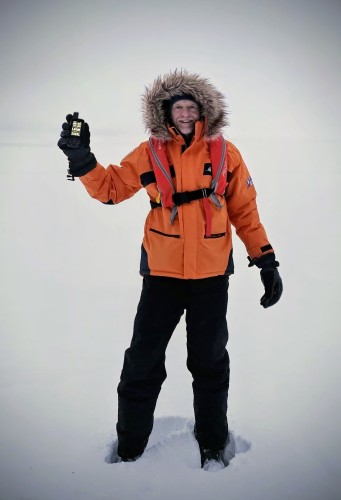Arctic
An expedition following the 1926 Amundsen and Nobile route from Svalbard to Alaska, taking in the Geographic North Pole, the Magnetic North Pole and the Northern Pole of Inaccessibility
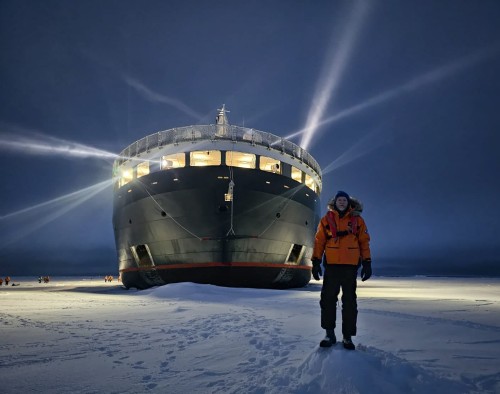
Details of the Expedition
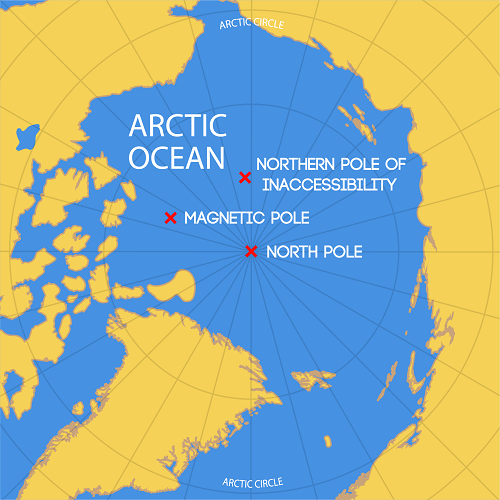
The Three Northern Poles
I've put this under the expedition category because it had a particular goal (reaching the North Pole and Northern Pole of inaccessibility) "using a variety of transportation methods" as opposed to doing it for the thrill (sitting on a boat for numerous days – see Point nemo – isn't as thrilling as it may sound). However, as expeditions go, this was a walk in the park. No 120mph ice storms, no threats from guerillas or insurgents, just a rather nice ice breaker!
Geographic North Pole
The terrestrial Geographic North Pole, or simply the North Pole, is the northernmost point on planet Earth. It is defined as the point where the Earth's axis of rotation intersects the Earth's surface in the Northern Hemisphere, where all the meridians and time zones converge. This geographic point is not fixed relative to the Earth's axis of rotation, as it oscillates slightly with a period of about fourteen months. Nevertheless, its position is often considered fixed for convenience.
The North Pole is located in the middle of the Arctic Ocean, above the polar abyssal plain (also called the Amundsen Basin or the Fram Basin) and near the Lomonosov Ridge. Directly beneath the pole, the ocean reaches a depth of 4,261 meters and is permanently covered by sea ice, unlike the South Pole, which lies on the Antarctic continental landmass. The temperature at the North Pole can vary between −43 °C and 0 °C, which favours the permanence of sea ice whose thickness ranges from two to four meters.
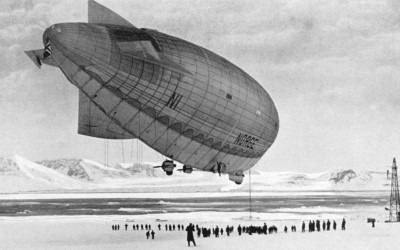
The Norge Airship at Ny-Ålesund
The first confirmed exploration of the North Pole is credited to the Norwegian Roald Amundsen and the Italian Umberto Nobile, who flew over it aboard an airship on May 12, 1926. That flight was in a semi-rigid airship called Norge, which Nobile designed and piloted. They departed Ny-Ålesund in Svalbardon May 1th 1926, crossed the North Pole at 1.25 am Greenwich time on May 12th and landed in Teller, Alaska (150km northwest of Nome) on May 14th
It was this epic journey that our adventure was following in principle, but on sea rather than in the air. We would sail from Ny-Ålesund to the North Pole and arrive back into Nome, Alaska. But we would also go via…
Magnetic North Pole
The Magnetic North Pole is the point on the Earth's surface where the planet's magnetic field points vertically downward. Unlike the Geographic North Pole, its position is not fixed and changes constantly due to fluctuations in Earth's molten outer core, which generates the geomagnetic field. Historically, the pole was first located in 1831 by James Clark Ross on the Boothia Peninsula in the Canadian Arctic.
Since then, it has drifted considerably, moving from Canada toward Siberia at a rate that has accelerated in recent decades, now exceeding 50 kilometres per year.
This wandering of the pole affects navigation, as compass needles align with magnetic north rather than geographic north, and it requires regular updates to navigation systems and the World Magnetic Model. Although located in the Arctic Ocean in recent years, the pole remains inaccessible by land, with its exact location shifting annually.
Northern Pole of Inaccessibility
The Northern Pole of Inaccessibility is defined as the point in the Arctic Ocean that lies farthest from any landmass, making it the most remote and difficult point to reach in the northern polar region. It is located at 85°48′N 176°9′E, about 1,008 kilometres from the nearest land.
Unlike the Geographic or Magnetic North Poles, this pole is not tied to Earth's rotation or magnetism but to the geography of surrounding continents and islands. The region is covered by shifting, thick sea ice that makes it extremely challenging to access, and it has rarely been visited compared to the other poles.
Its remoteness and the logistical difficulties of reaching it have made it a symbolic goal for explorers, although modern satellite navigation and icebreaker support have allowed occasional expeditions to approach its vicinity.
For more information about the Northern Pole of Inaccessibility, visit Inaccessibility.net
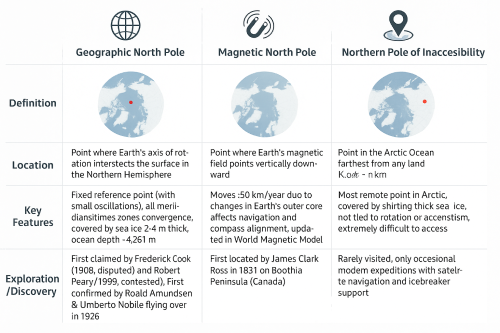
The Adventure Unfolds
On 5th September 2025, I first departed for Paris by air, changed airports, then flew direct to Longyearbyen. I'd hoped to spend a bit of time in town, having been stuck there for a few weeks back in 2019 on my original (failed) expedition to the Northern Pole of Inaccessibility. But time was against me and we went almost direct to the boat being used for the journey, The Commandant Charcot.
The CCis a hybrid-electric, LNG-powered icebreaking cruise ship operated by the French company Ponant. The ship is named after Jean-Baptiste Charcot, a French polar scientist and explorer. It has the highest ice-class rating of any purpose-built cruise ship, allowing it to break through ice up to 2.5 meters thick. The ship includes two science laboratories and research equipment to support scientific polar research.
On September 6th we arrived at Ny-Ålesund and paid a visit to the mooring mast used by the Norge airship. The village there hosts an international research centre and offers spectacular landscapes, majestic glaciers and fascinating wildlife. Indeed, while standing at the mooring tower, a young Arctic Fox came trotting by and stopped within 20 metres of us to see what we were up to. Just down the road we saw some Svalbard Reindeer which are rarer than Polar Bears.
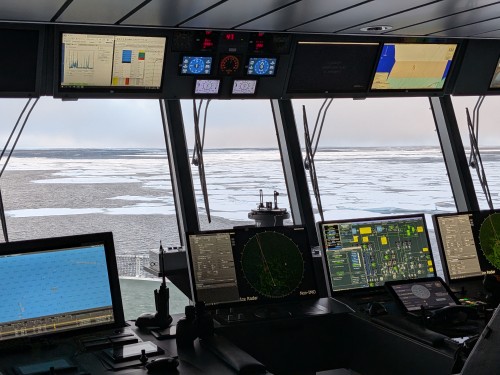
Commandant Charcot Bridge
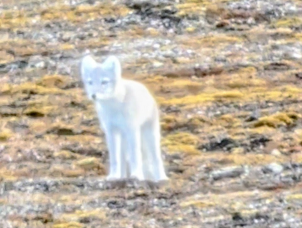
Artic Fox
The town also has a number of monuments to Amundsen and Nobile, as well a the North Pole hotel (which is 1200km from the North Pole – eat your heart out Ryan Air).
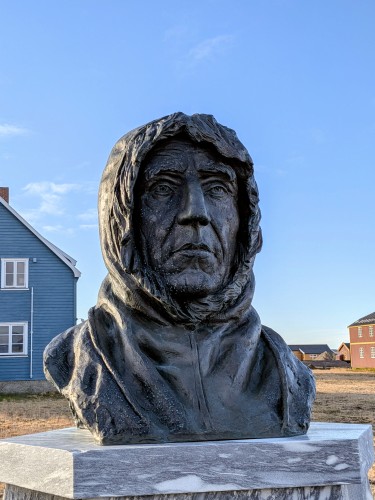
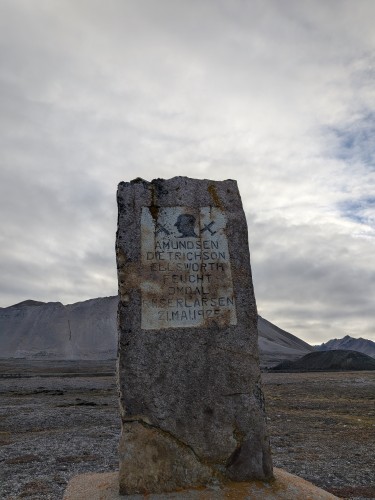
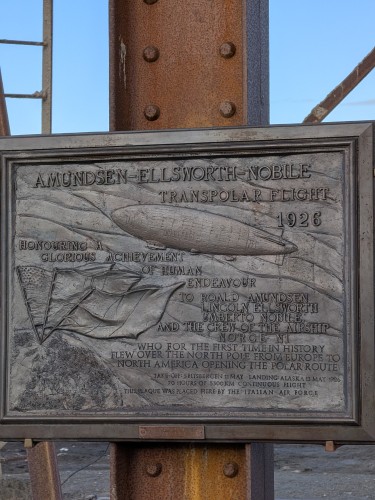
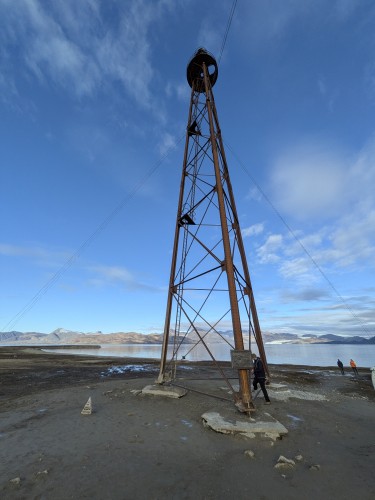
The boat then spent several days exploring the fjords of Svalbard such as Magdalenefjorden, Liefdefjorden, Monacobreen and Torellneset – all of which have rich histories (whaling, booo) and remarkable biodiversities (Walruses, yaaaay). We were able to see several Walrus colonies, trek over the hills and even go kayaking in the waters.
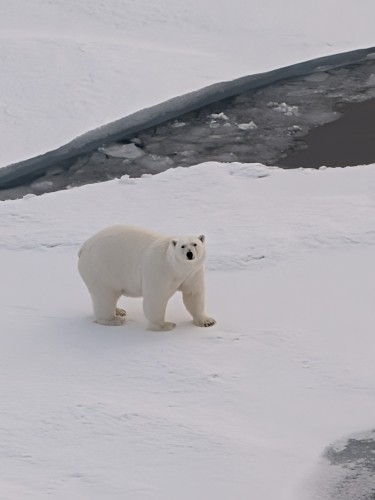
First Polar Bear I've seen
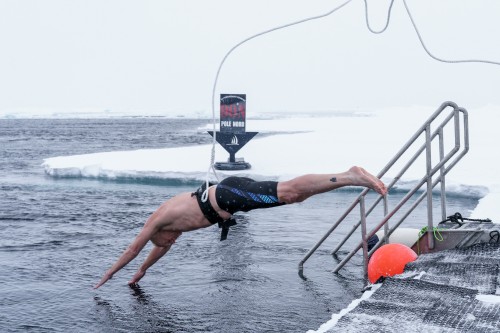
North Pole Plunge
On 11th September we set sail for the ice pack in earnest and, after a few stops for scientific measurements, we reached the ice proper on 12th September, which is also when we saw our first Polar Bears. First a wandering female took an interest in the boat and came over for a close look. Then only a few hours later we saw another female, this time with her grown-up cub. They too took an interest and came pretty close to the vessel. I'm happy to report that all three looked well-fed, so hunting in that region must be plentiful. Good news unless you are a seal.
On September 13th we arrived at the primary destination, the Geographic North Pole. The Commondant Charcot 'parked up' on some stable sea ice - basically they ram into thick ice and tether it there or keep the engines running just enough to hold steady – and we were able to disembark and explore the ice pack whilst the scientist performed their experiments.
One slightly touristy thing we did there was to do a Polar Plunge. Whereas regular "polar plunges" are where people jump into cold or icy water to celebrate the new year or for charity. It can also be a festive event, a personal challenge for bragging rights, or a fundraiser. Well, how about doing a Polar Plunge at the actual North Pole for bragging rights?
The Captain Patrick of the CC also indulged us (and himself) in a bit of fun by sailing around the world in just 12 minutes. A World Record? Quite likely. But this shows how setting time onboard a ship close to the North Pole is difficult. We'd have had to change our clocks one hour every 30 seconds.
Anyway, next up was some more ice navigation with spectacular views of the ice pack. I as constantly amazed how the boat seemed to effortlessly deal with the pack. Just think of all the great explorers who befell the terrors of pack ice crushing their boats, like Shackleton, De Long, Nansen and Franklin. If only they'd had a ship with the integrity of the CC.
On September 16th we arrived at the best calculation we could make for the Magnetic North Pole. This was an interpolation of the coordinates at the start of 2025 and the estimated coordinates at the start of 2026. The location was Latitude: 285°37'N, Longitude: 136°54'E, around 1300km from the regular North Pole.
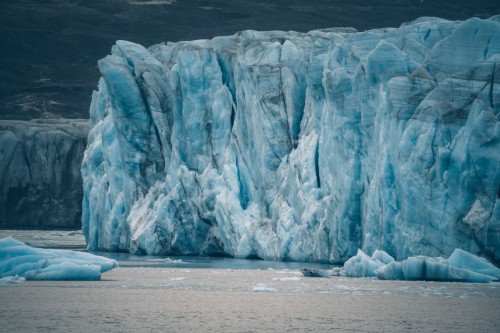
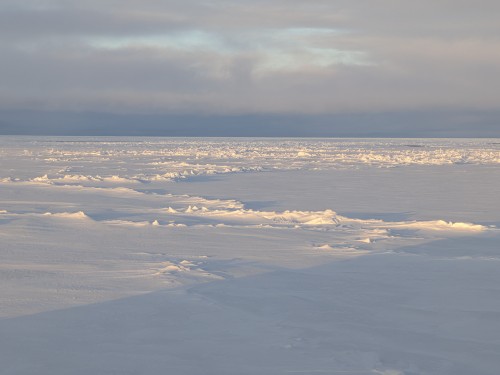
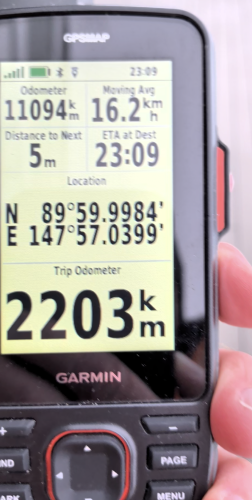
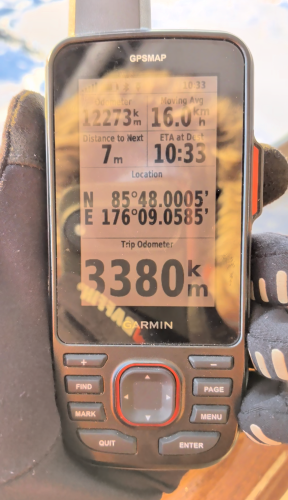
As per, the compasses onboard were spinning and 'not happy'. But we could not find the ships declination compass (a compass which points up and down in addition to along the surface of the planet) to verify the positioning. Close enough, I think is the phrase.
Another day of ice pack navigation brought us to my personal Primary Objective: The Northern Pole of Inaccessibility and #7 in my quest to visit all eight such poles.
Quite late at night, or whatever passed as arctic night for those on board (see discussion on ship time above) we arrived within the 1km error margin of the pole's coordinates: Latitude: 85°48'N Longitude: 176°09'E. However, we wanted to get to the exact coordinates on foot if we could. So the captain parked the boat again on some firm ice that had been calculated to flow towards the pole during the night and we'd wake up at the pole and be able to go and explore on foot.
Duly parked 1.5km from the pole, we went to bed and woke up to find ourselves 7.5km away. Doh!
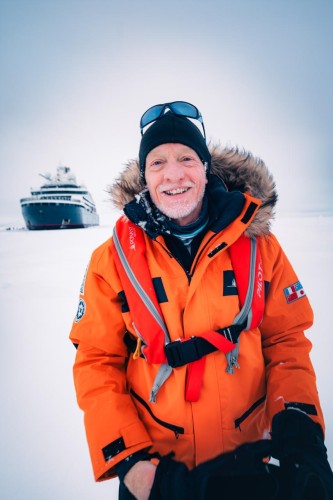
The boat did reposition closer to the pole, but not within the 1km, for us to explore the ice and for the scientists to make their measurements. The exact coordinates of the Arctic Pole of Inaccessibility were not accessible on foot because of cracks in the ice pack making it too dangerous. So, once we were back on board, the last few metres were achieved by sailing through the pole. I recorded us within 7 metres of the exact coordinates on my hand-held GPS. Definitely close enough!!
That's really the exciting part of the expedition over. It took another seven days of sailing to arrive into Nome in Alaska on 25th September. But not before we encountered some more polar bears at the edge of the pack ice. This time they were two individual males. Both were less interested in the ship than the females and didn't let us get too close. And the final treat for us was a strong showing of the Northern Lights, with a green display covering about a third of the horizon.
